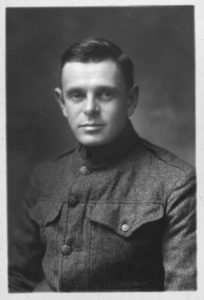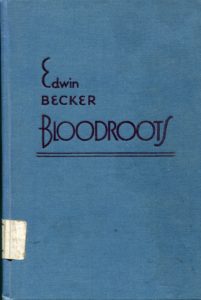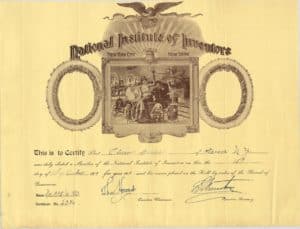Edwin Becker: Inventor, Poet and Engineer
By Becky Chapin, Archivist
I’ve never been a big poetry person. Poems really never made much sense to me, though I still try whenever I come across some interesting sounding volumes. Several years ago, I spent a semester working on a small part of a massive collection (156 containers) in the University at Buffalo Poetry Collection which detailed the life of an incredibly interesting person called Paul Mariah who was a poet, magazine publisher, and belonged to several gay, religious, and prison activist groups in the San Francisco area. The work I did on that collection taught me to look deeper into the materials we have, to dig up all we can and bring our history into the light.

During World War I Edwin Becker worked at the Ordnance Depot for six months.
When I stumbled upon Edwin Becker’s books of poetry in our collection, I was really only interested in the number of volumes he published (seven altogether, not including other publications). But going through his collection reminded me of my work at UB. Becker didn’t even start writing poetry until he was past fifty years old, which left so much more of his life to discover.
Edwin was born in Geneva on January 18, 1887 to William and Carrie Becker. Carrie’s father was Samuel Jones who operated a lumber yard and planning mill in Geneva where the Patent Cereals factory was later built. In fact, Jones eventually sold this land to the Lichts in 1888. Jones’ lumber yard took up a large expanse of Bradford and Canal Streets, with his house located on Canal Street across from the saw mill and offices. In his childhood, Edwin was fond of drawing and mathematics, attending a grammar school in Geneva but not advancing into high school; instead he did correspondence courses, read books, and spent time “out-of-doors.”

Home of Edwin Becker’s grandparents Samuel and Isabella Jones in 1876. Shown in photograph is Edwin’s grandmother and mother.
His World War I draft card and city directories list his occupation as a nurseryman working for TW Smith & Co (W&T Smith). His grandfather, Daniel Becker, was also a nurseryman who planted cherry trees in his orchard on a street that would eventually be named after those trees, Cherry Street. On the east side of that street, Samuel Jones grew hay, corn and beets. Edwin himself would live on Cherry Streey for a greater part of his life.
He enjoyed collecting fossils and minerals, later giving some to the Nature Museum, including fossils that he found in Kashong Gully.
There’s an earthborn fossils’ heaven
In the gully at Kashong
In July we hunters took
Trilobites a footbreadth long.
Underneath the Lake Road bridge,
We began to search the rock.
Soon we met four lank sea-shells
Anchored to a black shale block…
-two stanzas from “Fossil Hunters at Kashong”
As a young man, Edwin became interested in inventing things, developing a number of devices including freezing machines, gas analyzers, a vacuum oyster opening machine, and a street car speed indicator. In February 1918, he gave the War Department a poison gas device which was tested by the government and kept in confidential records after testing (further attempts by me to locate the record have been unsuccessful). He worked as an engineer for the Empire Coke Company in Border City, but later declared “engineering was not for him.”

Cover for Edwin Becker’s first book of poetry titled “Bloodroots.”
Edwin published his first book of poetry in 1939 at the age of 52, stating that “he never thought to [write]” poetry before then, but “after composing a few poems he was convinced that he was qualified for the work, so started in.” Drawing his inspiration from his experiences and his childhood, he often wrote of Geneva and Seneca Lake, flowers, birds, scenery, and nature. He went on to dedicate his other publications to birds, rocks, Loomis Woods, and his mother, respectively.

Title page for Edwin Becker’s “Out of the Finger Lakes Country Part III.” He dedicated it to Loomis Woods.
A year before his death in 1957, Edwin wrote for in the Geneva Daily Times and his autobiography that he had solved the mystery of the ‘guns of Seneca Lake’ legend while camping with some friends in 1905. The loud boom was caused by gas bubbles that would rise through the water, bubble popping at the surface of the lake causing the boom.
Edwin’s poem “A Few Hours in Lake Side Park.: We have many of Edwin’s poems, handwritten, typed, and officially published versions, in our archives. The poems are an interesting perspective on Geneva, growing up, and the beautiful landscapes in the Finger Lakes. To close, here are the first 4 stanzas of Becker’s poem entitled “A Few Hours in Lakeside Park” written in Edwin’s hand.

The poem “A Few Hours in Lake Side Park:”
The leaves above me weave a shade
That shield me from the sun.
I sometimes sit upon this bench
Before the day is done.
I have no care, I only know
that there is rapture here,
When looking at that long blue lake
Whose beauty has no peer.
From Populus or plane, close by
A robin lilts to me;
Now comes the devil downhead’s “quanks”
Low on a rough barked tree.
A train, along the opposite shore,
Is curving toward the west.
It whistles near the Outlet bridge-
Slows down, then comes to rest.

